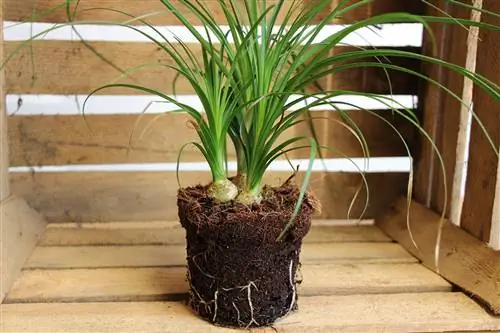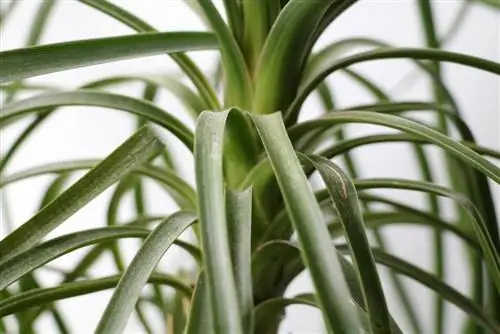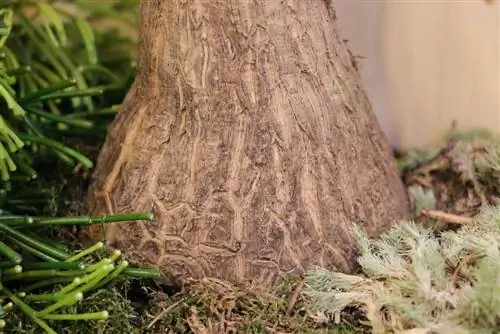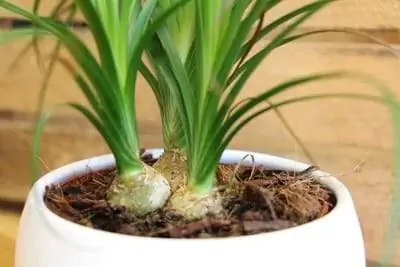- Author admin [email protected].
- Public 2023-12-17 03:39.
- Last modified 2025-01-24 12:45.
Hobby gardeners tend to neglect the elephant's foot because of its undemanding nature. They often only notice that something is wrong when the otherwise robust plant begins to ail. In addition to the right location and the appropriate supply of water and nutrients to the elephant's foot, regular repotting is also necessary to keep the plant vital and in excellent he alth well into old age. The right substrate plays a very important role here. This is the only way the bottle tree can develop sufficiently well and is protected against diseases and pests.
When does the elephant foot need to be repotted?
A very easy way to tell when your elephant's foot needs a larger pot is to check the roots. Beaucarnea recurvata should therefore be pulled out of the pot every spring. If the roots already form a fine network on the outside of the root ball, it is time for fresh soil and a slightly larger pot. However, roots in the drain hole are not a sure sign. Sometimes a few individual roots grow in one plant or another without the rest of the substrate being fully rooted. That's why the entire root ball should always be inspected before repotting.
Detecting used soil
If you water with very calcareous water, you will slowly but surely increase the lime content in the substrate. However, because the elephant's foot prefers a slightly acidic soil environment, high pH levels are not good for its overall he alth. A sure sign of salinization is a white or yellowish crust on the surface of the substrate. Crusty deposits on the outside of clay vessels also indicate these problems. In these cases, it makes sense to free the Beaucarnea recurvata from the old soil at the next opportunity and place it in fresh substrate. The plant therefore does not necessarily need a larger pot.
Repotting
Beaucarnea recurvata can be cultivated in the same container for a long time if watered with low-lime water and fertilized regularly. Nevertheless, after a while, the elephant's foot will slow down its growth and the plant will lose its usual vigor. This is because the roots spread out in the planter, taking up more and more space and thus displacing the soil. Therefore, all plants must be potted into larger containers and fresh substrate at regular intervals.
Repotting young plants
Until the elephant foot reaches its final size, it grows faster and therefore needs to be repotted more often. The ideal time for repotting is early spring, i.e. between the end of February and the beginning of March. Repotting is easiest when the root ball is well dried, as in this case it is easier to shake the old soil out of the roots.
- Time: early spring
- remove any incrustations on the surface of the bale
- Pot size: 2 to 4 cm larger diameter than before
- Put a drainage layer in the new pot (shards of pottery, gravel, etc.)
- only use clean pots (potential disease vectors)
- Water clay pots for some time before planting
- Place some fresh substrate on the drainage layer
- Insert plant and fill with substrate
- Carefully push the soil into the gap with your finger or a spoon
- water lightly
In the following two to three weeks, the elephant's foot should be protected from direct sunlight. A plant planted in high-quality substrate will usually recover quickly from the stress caused by repotting or removing some roots and will soon sprout vigorously again.
Repotting older plants
If the elephant's foot is in high-quality substrate, it only needs to be repotted every four to five years. Specimens planted in normal standard soil require fresh soil annually.
- cut off all dead roots and plant parts
- If necessary (lack of space), living roots can also be removed
- cut a maximum of about 10% of the living roots
- other conditions as for young plants
Tip:
Tight roots can be removed from the pot with a long, thin knife. If many strong roots have already grown out of the drainage hole, it is always better to smash or cut the plant pot than to destroy the roots.
Substrate change for very large plants
If the elephant's foot has already reached an impressive size, it is often no longer possible to repot it into a larger planter due to space constraints. Nevertheless, the plant needs fresh substrate every now and then. In these cases, one option is to change the soil on the surface of the root ball. However, this is only recommended if it causes little or no damage to the roots of the plant.
- carefully scrape off the old layer of soil with a spoon
- remove as much substrate as possible without damaging the roots
- fill with substrate to the original height
- Add a small amount of slow-release fertilizer straight away
- Don’t set the amount of fertilizer too high
Pruning the roots of old plants
In the long run, replacing the top layer of soil is not an adequate replacement for repotting. The roots continue to grow and eventually fill the entire planter. As a result, they can no longer absorb enough water and nutrients. For this reason, it is essential to prune the roots of the bottle tree if a larger planter is not possible.
- Water the root ball well before repotting
- Removing the elephant foot from the planter
- put on newspaper
- cut thick slices all around the outside with a sharp, clean knife
- Thickness: about 2 to 3 cm
- Clean the planter thoroughly
- then put it back in the old pot
- fill with high-quality substrate
Tip:
After this radical measure, it is very important to ensure ideal location and growth conditions so that the elephant's foot can survive the shock.
Substrate
Ideal for caring for the elephant's foot is a well-drained substrate with a pH value between 5.8 and 6.8. Since the plant rarely needs to be repotted due to its slow growth, great importance should be placed on high-quality soil become. Cheap standard soils from the supermarket are only suitable to a limited extent because they usually do not guarantee nutrient and water regulation over a longer period of time. It is also important that the substrate can provide a certain buffering capacity. If the elephant's foot is watered with normal, lime-containing tap water, the pH value can quickly drift into alkaline (pH value above 7). This is bad for the otherwise undemanding plant in the long run.
A perfectly adapted substrate is easy to mix yourself. It is not difficult to produce and as a reward you will receive a permanently vigorous and he althy plant that remains largely resistant to diseases and pests. The self-made substrate has another advantage: it does not collapse over time and therefore does not become compacted. This means you can avoid repotting every year.
Substrate mixture
- 4 parts peat substrate, peat moss or slightly acidic humus substrate
- 2 parts clayey soil
- 1 part sand
- 1 part lava granulate, pumice gravel or expanded clay
Tip:
When purchasing potting soil, you should make sure that the pH value is stated on the packaging. It should be between 5.8 and 6.8 so that the bottle tree can develop he althily.
Diseases and pests
Pests and diseases occasionally occur on the robust elephant foot. This is especially the case in the dry, warm winter months when the apartment is heated. In addition, various care errors are involved when Beaucarnea recurvata becomes ailing.
Pests
- Common spider mite: Spider mites can be easily recognized by the webs in the leaf axils, and sometimes dented feeding spots appear on the edges of the leaves.
- Scale insects: These parasites hide quite well and are therefore not always immediately recognizable. A clear sign of a scale insect infestation can be seen in honeydew, which are small sticky droplets that hang on the edges of leaves. The scale insects themselves usually sit deep in the leaf axils or on the underside of the leaf with their curved dorsal shields.
- Thrips: Heavily infected plants lose vitality and show growth disorders, the leaves slowly die off.
- Mealybugs and mealybugs: The pests can be recognized by a fine web that resembles tiny cotton balls.
Combat
Since many of these pests can only be recognized when the elephant's foot is already showing clear signs of illness, regular checks are particularly important. Deformed leaves, webs, thickening and corking of the leaves as well as yellowing of the foliage are the first signs of an infestation. Most parasites can be easily controlled, especially in the early stages.
- Wipe leaves with a damp cloth
- especially the undersides of the leaves
- alternatively, rinse off in the shower
- remove visible parasites with a damp cotton swab
However, if the first signs are overlooked and the parasites are not carefully removed, conventional methods of combating them are no longer sufficient. The pests are able to reproduce within a short period of time. At the slightest sign of massive spread, a plant protection product is often essential to save the elephant's foot. Insecticides are available as sprays, in liquid form or as a combination product with fertilizer. However, in order to combat it, it is very important to accurately identify the pest. For certain parasites, biological agents such as parasitic wasps are also possible. These should be preferred over contact poisons in closed living spaces. The bottle tree also reacts sensitively to certain substances. Therefore, seek detailed advice from a specialist retailer before using such a product.
Diseases and harmful images
If the lower leaves of the leaf cluster turn yellow over time and then die, this is no cause for concern. This is also completely normal in the wild, as long as the elephant's foot remains vital and regularly sprouts fresh greenery. The dead leaves can be carefully removed. A white trunk section initially appears underneath, which over time becomes woody and looks like the rest of the bottle tree.
- young leaves turn yellow: excessive watering is usually to blame. Root damage may have already occurred due to waterlogging. A temperature shock can also trigger wilting if, for example, the air is ventilated for too long in winter.
- Floppy new shoots: Check the location for lack of light. These long, colorless shoots indicate a lack of light. The elephant foot may need to be moved to a brighter location.
- dried leaf tips: Since the elephant's foot is not sensitive to low humidity, in this case there is usually a lack of water. Either water the plant at slightly shorter intervals or dip the root ball occasionally in summer. Waterlogging must be avoided at all costs.
Conclusion
It is best to check the root ball annually in spring for root penetration. Younger plants usually need a slightly larger pot every year. An older elephant foot only needs to be repotted at intervals of three to five years. If a larger planter is no longer possible, the top layer of substrate can be renewed annually and the roots can be pruned every few years. A very high-quality substrate is important.






